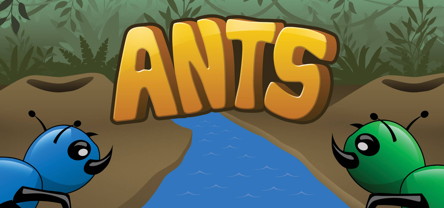|
We woke up early for a 7:30am guided walk. We were the only ones able to get up that early,
so we got a private walk. We had the same guide from yesterday. We walked across the sheep farm
again, and then up the hill. Along the way we saw lots of sheep droppings. Apparently they go up the hill
during the night -- instinctively to avoid predators, even though there aren't any on the island. When we
arrived at the top of the hill, hundreds of them looked at us inquisitively before slowly plodding away.
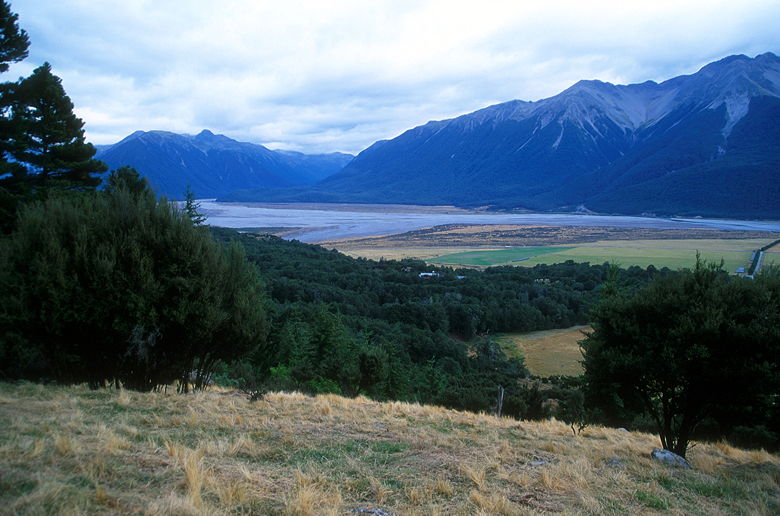
View from the top of the hill
Our guide mentioned that the English settlers brought their whole lives with them in ships. They
brought birds, plants, animals. New Zealand has no native mammals except for two species of bats. But now
there are all sorts of mammals, including some which endanger some of the existing bird species.
We had great views of the valley below as our guide talked about forests. Apparently the
Douglas fir which had been introduced was now making headway into the surrounding mountains. They are
impressive trees in that they can grow on very steep terrain -- something the native trees aren't as good at
doing. The guide also mentioned an interesting gap of beech forest. Apparently the last ice age caused a gap
in the beech forest which is very slowly being closed. The gap runs between somewhere near Arthur's Pass to somewhere
near Fiordland.
After enjoying the view, we headed downhill into the arboretum. Back in the 1940's and 50's, the
people here planted rows of non-native trees to see what would grow best. There are 17 species left in the
arboretum, including Monterey pine, bristlecone pine, spruce, Colorado fir, Douglas fir, and a strange-looking
tree called the Monkey Puzzle (a native of Chile). Bristlecone pines are some of the oldest living things,
most notably found in the White Mountains of California. However, the one we saw in the arboretum looked
nothing like the ones which grow in California. They grow in a completely different environment, of course.
We descended out into the open fields from the arboretum, only to be attacked by a couple of
dogs. Andy (the farm manager) called them away from us, and we returned to the lodge for breakfast.
Breakfast, as with the rest of the lodge food, was excellent. I had pancakes with grilled bananas. Yum.
We talked to the guide about our plans for the day. It was overcast, and she said going to
Avalanche Peak on such a day wasn't really worth it. It's too steep to be much fun, and its peak was currently
covered in clouds. So she encouraged us to do Bealey Spur instead. She even gave us a map, though we would
end up not needing it.
So that settled it. After breakfast we took our box lunches (actually bag lunches) and made the short
drive to the parking lot for our hike. Then we went off toward Bealey Spur. After the hike we returned to the lodge to rest before our next activity. I called the bus company
to make reservations for doing the Routeburn track starting on Friday. I had tried to call while still in
the states, but they told me to call the day before to make reservations. I decided that was cutting it a bit
close so I called two days in advance.
At 5pm we gathered for our next activity, to learn all about sheep farming. Andy, the farm
manager, took a large group of us (pretty much everyone in the lodge) out to the farm. The wilderness lodge
is built on a sheep farm -- Cora Lynn Station. It has about 3000 sheep. Andy showed us his two dogs,
a big barking dog, and a small quiet dog named Meg. We walked out into the field and looked up to see the
sheep eyeing us from he top of the hill (the same one we'd hiked on in the morning).
Andy sent Meg up the hill to go bring the sheep down.
Meg disappeared for a few minutes before we started seeing the sheep. Andy used his whistle
(mainly for encouragement), and vocal commands. He said he could control her for up to a mile away. Meg
didn't make any sound as she rounded up the sheep and forced them down the hill to us. She simply ran around
from one side of the herd to the other.
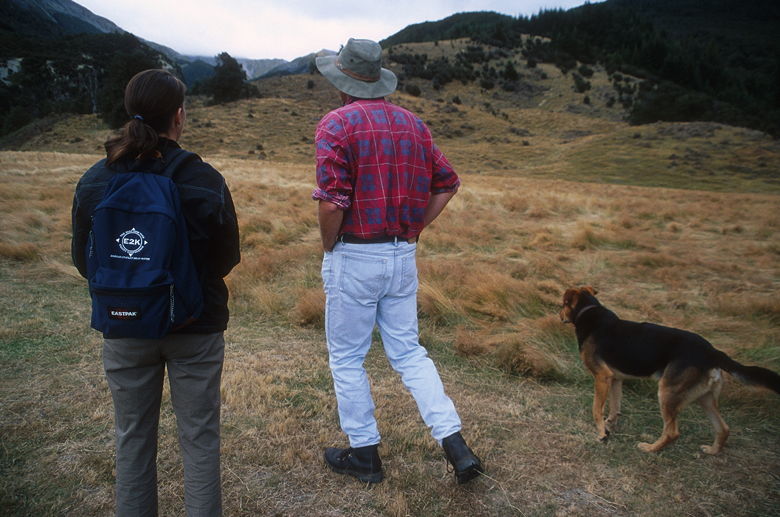
Andy calling out to Meg
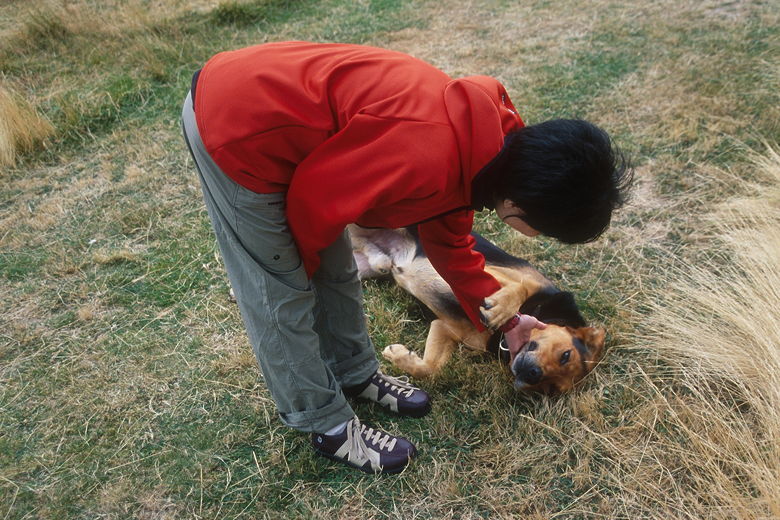
Jean playing with the other sheep dog
Meanwhile, the other dog was getting antsy, barking and running around. I asked Andy if the
sheep would move faster if Meg barked. He said they probably would, but she only barks if she's real
excited. Now that the sheep were down, he sent the second dog to chase them back up the hill. He gleefully
jumped up barking and running at the sheep, who definitely moved faster up the hill.

Meg mustering the sheep down the hill

Getting closer
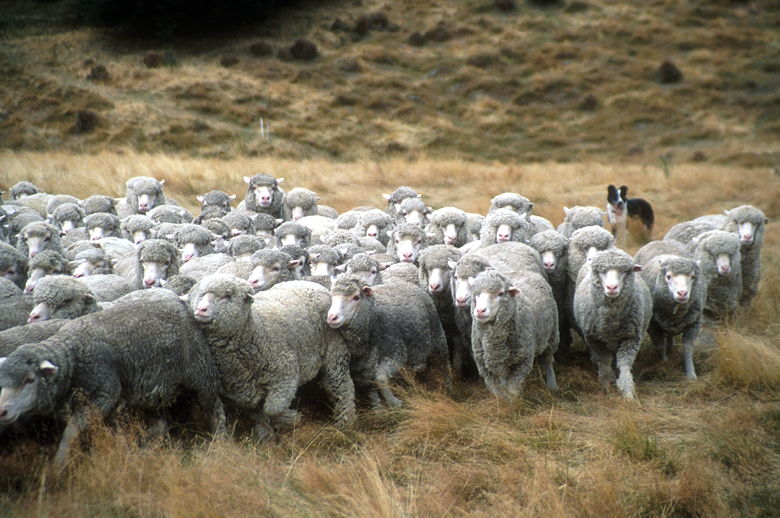
All the way down
Andy lamented the fact that a good dog could only give about 6 years of prime service. Those
dogs must get pretty tired running up and down those hills, back and forth. After this mustering demonstration,
we walked down to the shearing shed.
The wool from Cora Lynn station goes to some of the finest Italian fashion makers. Now, you might
think of New Zealand as being isolated and unconnected with the rest of the world, but Andy put those thoughts
to rest. He pointed to a pile of wool on the wool table and said that before September 11th, he could
get $34 for it. Now, he can only get $12 because Americans aren't buying expensive suits, so the fashion
makers aren't buying the wool. Interestingly, he says that sheep meat prices haven't been affected. People
still have to eat, but they don't have to do so in an expensive suit.
Andy dragged an ewe from the back and started shearing it. They hire 7 contract shearers for 3
days every year to shear all 3000 sheep on the farm at once. Each shearer can do about 125 sheep a day, and
gets paid $1.60 per sheep. The farm sets aside 100 sheep which they then shear one at a time, every other
day, for lodge visitors. But nothing's just for show -- all the wool from such shearings is used. Nothing
is wasted.
Andy sheared by hand. He said an electric would shave too close, stripping the sheep of vital
wool which protected it from the high mountain elements during the winter. To the surprise of many of us,
the ewe was extremely docile, hardly moving while the shearing took place. I guess they know better than
to squirm. Andy said the key was to control the head (by placing it between your legs). Another thing
I learned -- you can tell a sheep's age by counting its teeth.
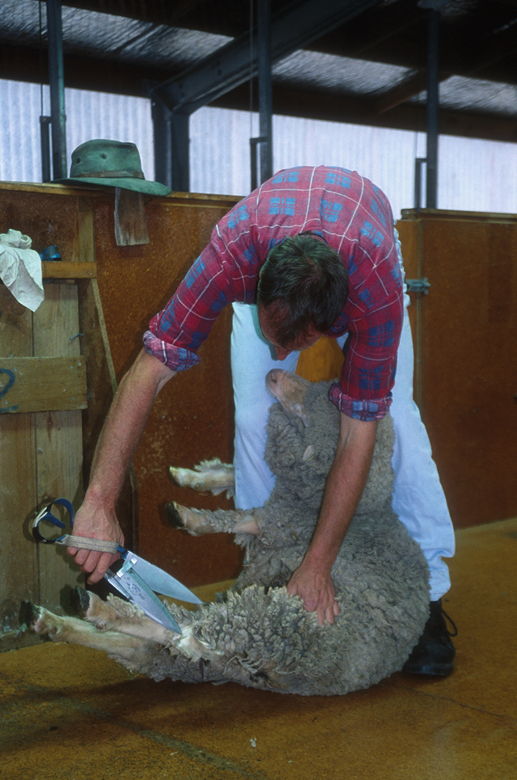
Andy starting to shear a sheep
After doing part of the shearing, Andy asked for volunteers to give it a try. Jean yelled out
that she would try, and she got up on stage and gingerly took a few snips. A few other guests also
tried their hand at it. It was all good fun, with Andy answering all of the many questions we had. He
complained that it was very hard to get farm help these days. He said it's a worldwide problem, as
people want to move into the big urban centers and don't want to work on a farm anymore. It seems like
a tough life, hard to take vacations. He said -- "sheep are cute until you have 3000 of them."
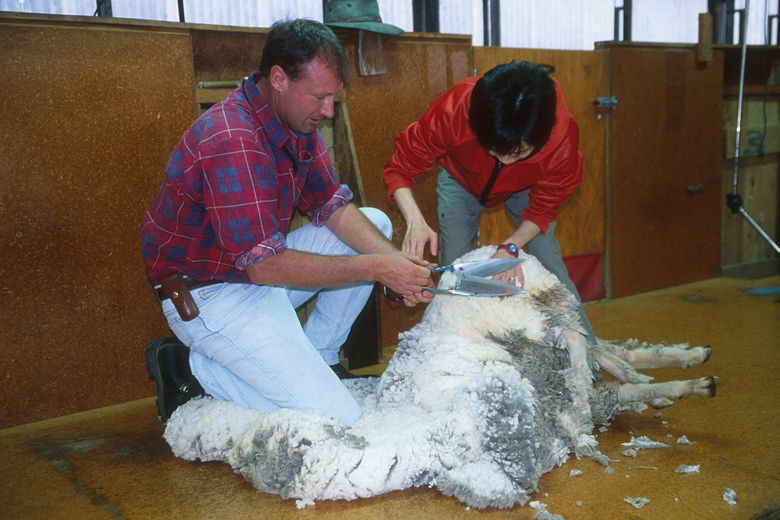
Jean about to take her turn
Jean said she could feel the oil in the wool (lanolin). Andy said it would only take about a
year for the wool to grow back. He finished shearing the ewe and then threw the wool onto the wool table.
He sorted it, separating the wool around the head, the wool around the legs, and the wool from the back.
The rest was the highest quality, but everything would be used. The wool will be separated according to
quality, put into bales, and sold at auction. The buyer will have the task of cleaning and processing it.
Andy said it's a 34-step process from sheep to suit.
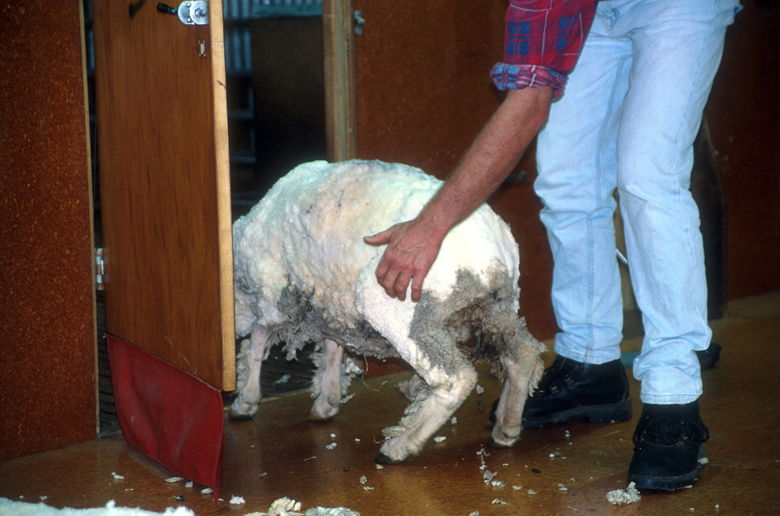
Fully sheared sheep going into the back
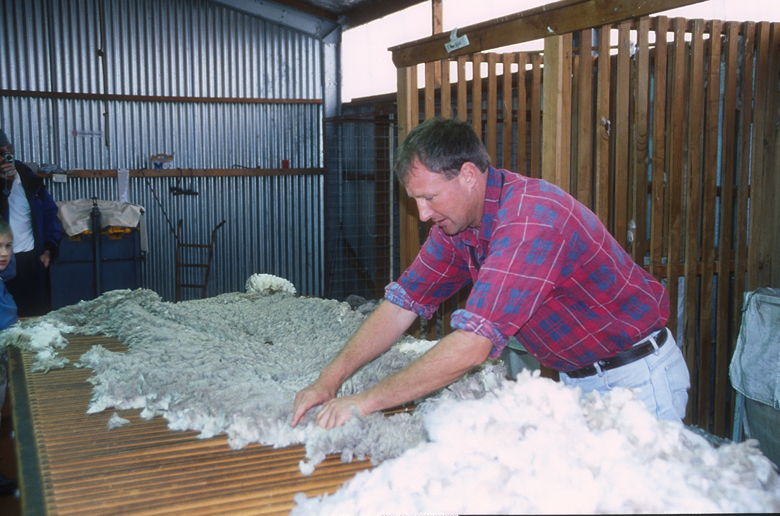
Sorting the wool on the table
Oh, and the tails are cut off when the sheep are 6 weeks old, to keep the wool clean. Apparently
some people throw the tail on the BBQ and eat it.
Tonight the lodge was a bit fuller, as the Japanese (who were probably one person per room) had
left, to be replaced by a couple of tour groups from California. Gerry McSweeney (part owner of the lodge),
as he had the previous night, greeted us all at about 7:30pm in the common area. He introduced everyone and
talked about what people had done during the day. He's an energetic guy who leads some of the lodge activities.
We dined with 3 other couples tonight. There was Jean and Allen from Los Altos, Mervyn and Diana
from England, and Peter and Froukje from the Netherlands. We had a lively conversation concerning everything
from politics (or politicians) to food and travel to homeless people. Mervyn was quite amusing, bellowing out
in a loud voice which made him sound drunk -- and that was before he started drinking the wine. He claimed that
British restaurants are very good these days, despite the prevalent jokes about British food. Mervyn and Diana
were on a 10 week vacation going around the world (next stop Singapore). Coincidentally, they also stayed at
the George hotel in Christchurch and would return there later in their trip. He said when they went to the
Pescatore restaurant without reservations, they refused to seat him, even though there were clearly free tables.
The restaurant's whole attitude needs an adjustment.
Dinner here at the lodge was great as expected. We started off with kumera soup. I had salmon while
Jean had the lamb. Cheesecake for dessert. After dinner we went upstairs for a slide show presentation by
Gerry. We learned a few things about the natural history of New Zealand. Originally the islands were 80% covered
by forests. The Maoris arrived about 700 years ago and started burning the forests to create clearings for
agriculture. By the time the Europeans arrived about 300 years ago, the islands were only 40% covered by forest.
Now, there's only about 20% forest cover. I would imagine a large percentage of the land is now instead
covered by sheep and cattle farms.
Gerry extolled the virtues of the Kea bird, which apparently is one of the most intelligent animals on earth.
He also talked a bit about Lake Moreaki penguins. The Arthur's Pass Wilderness Lodge has a sister lodge at
Lake Moreaki. Jean and Allen had already stayed there, and said it was a little more rustic than the
Arthur's Pass lodge. Still, it seems like it would be a nice place to stay -- it's certainly more remote.
| 









